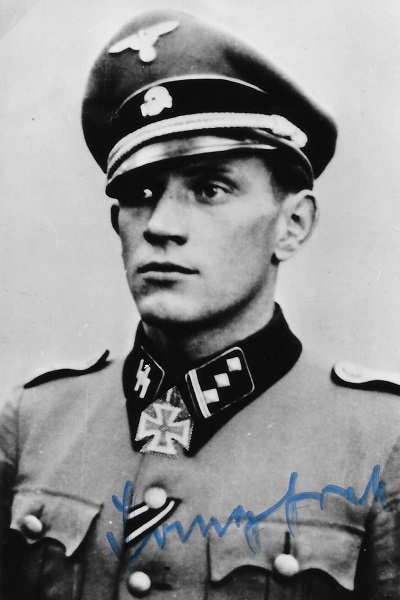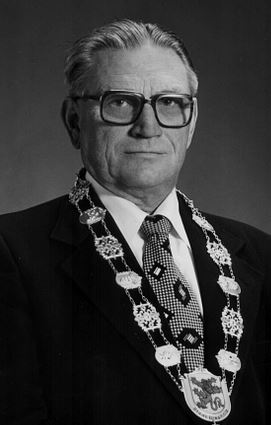Langhorst, Bernhard (Waffen SS)
- Date of birth:
- December 13th, 1913 (Diepholz/Hannover, Germany)
- Date of death:
- July 8th, 1996 (Diepholz/Lowersaxony, Germany)
- Service number:
- SS-Nr.: 202.201 // NSDAP-Nr.:
- Nationality:
- German
Biography
SS-Sturmbannführer d. R. Friedrich Theodor Bernhard Langhorst
Promotions:
01.09.1942: SS-Untersturmführer der Reserve
21.06.1943: SS-Obersturmführer der Reserve
21.06.1944: SS-Hauptsturmführer der Reserve
00.04.1945: SS-Sturmbannführer der Reserve
Career:
01.09.1939: entered the SS
00.05.1940: WIA - campaing in the West
01.09.1942-14.10.1942: SS-Ustuf d.R., SS-Unterführerschule Radolfzell
14.10.1942: SS-Ustuf d.R., Stabskompanie, Estnische SS-Freiwilligen-Panzer-Grenadier-Bataillon 'Narwa', Estnische SS-Legion, SS-Truppenübungsplatz Debica
00.00.1943: 20. Waffen-Grenadier-Division der SS (estnische Nr. 1)
22.10.1943: SS-Ostuf d.R., Chef, 14. (IG) Kompanie, II. Bataillon, SS-Freiwilligen-Regiment 42 and Chef, SS-Panzerjäger-Abteilung 53
00.07.1944: SS-Hstuf d.R., WIA
17.07.1944: SS-Hstuf d.R., SS-Sturmgeschütz-Ausbildungs- und Ersatz-Abteilung
00.01.1945: SS-Stubaf d.R., Kommandeur, SS-Freiwillige-Panzerjäger-Abteilung 20, 20. Waffen-Grenadier-Division der SS (estnische Nr. 1)
00.00.1961-00.00.1979: Bürgermeister, Diepholz
Do you have more information about this person? Inform us!
- Period:
- Second World War (1939-1945)
- Awarded on:
- June 22nd, 1940
- Period:
- Second World War (1939-1945)
- Awarded on:
- June 30th, 1940
- Period:
- Second World War (1939-1945)
- Awarded on:
- 1941
- Period:
- Second World War (1939-1945)
- Rank:
- SS-Obersturmführer der Reserve (1st Lieutenant of Reserves)
- Awarded on:
- March 8th, 1944
- Period:
- Second World War (1939-1945)
- Rank:
- SS-Hauptsturmführer der Reserve (Captain of Reserves)
- Unit:
- Kommandeur, SS-Freiwillige-Panzerjäger-Abteilung 20, 20. Waffen-Grenadier-Division der SS (estnische Nr. 1)
- Awarded on:
- April 5th, 1945
“On the 05.02.1945 the enemy succeeded in pushing out of their bridgehead over the Neisse (west of Frohnau) with tanks and strong infantry forces. They broke through our security line along the Neisse and Oder rivers between Frohnau and Schwanowitz along a broad front towards the south. Simultaneous enemy attacks from the Eichenrieder forest towards Borkenhain and from the Eichenried bridgehead towards Schurgast succeeded in pushing back local alarm units and capturing the city of Schurgast following the death of the city’s commandant.
SS-Hauptsturmführer Langhorst, commander of the SS-Pz.Jg.Abt.20, recognized the threat that this penetration created for the open left flank of the Division. Acting on his own initiative, he launched a counterattack with only 20 men and 2 Jagdpanzers from his Abteilung against the battalion-sized enemy force that had crossed the Oppeln—Brieg railway line near Arnsdorf and Rauske. In a bold strike Langhorst’s men were able to throw the enemy back beyond the Arnsdorf railway station and recapture Rauske. SS-Hauptsturmführer Langhorst then created a new security line using gathered up stragglers and members from the supply Kompanie of his Abteilung, connected it with the friendly elements of the Regiment 46 at Niewe, and held it. During this time SS-Hauptsturmführer Langhorst proved to be the soul of the resistance by way of his personal example. Through efficient organization he succeeded in mounting the resistance in such a way that two new enemy attacks against Arnsdorf were repulsed and a second enemy penetration at Rauske was cleaned up via a counterthrust.
In the early morning hours of the 06.02.1945 the enemy succeeded in thrusting through a security line that had been recently created by the Division on the southern bank of the Neisse between Löwen and Rauschwalde, specifically near Gross and Klein Sarne. The enemy had once again torn a hole on the left flank of the Division (this one about 8 km wide), and was freely pressing ahead to the south and southeast. This created an acute threat to both the deep flank of the 20. Waffen-Gren.Div. der SS (estn.Nr.1) as well as to the left flank of the Korpsgruppe Siehler. Sparing the friendly occupied localities of Strassendorf and Klein Hilbersdorf, the enemy took control of Klein and Gross Sarne.
SS-Hauptsturmführer Langhorst received the mission to halt the enemy in the hilly terrain Mullwitz-Rautke. For this task the Division could only spare him 100 men that had recently returned from leave. As SS-Hauptsturmführer Langhorst entered Mullwitz the enemy was meanwhile hotly pursuing retreating friendly infantry. They attacked and captured Graase, thereafter continuing their drive to the south. Acting on his own initiative, SS-Hauptsturmführer Langhorst attacked the battalion-sized enemy force that had advanced past Graase with the support of a 2 cm Flak Zug from his Abteilung. He threw the enemy back beyond Graase to the north and in doing so enabled a security line to be built in the hilly terrain at Mullwitz-Rautke.
At the same time SS-Hauptsturmführer Langhorst succeeded in collecting stragglers and fleeing infantry at a fallback line located on the hills northwest of Mullwitz. Showing flexible leadership and tireless devotion to duty. he formed these into a Kompanie which had been deployed as a garrison for Graase by nightfall. In this hour as well SS-Hauptsturmführer Langhort was the soul of the resistance. Wherever the resistance of the already hard pressed friendly infantry threatened to wane it was always SS-Hauptsturmführer Langhorst (himself fighting with grim determination) who would personally lead back fleeing squads to their positions immediately. With this it was always possible to throw back the advancing enemy (who were always aided by strong fire support) until a freshly arrived Bataillon finally arrived to aid the battle for the important hill line on the 07.02.1945.
A sketch of the situation on both the 05. and 07.02.1945 is included with this recommendation.
By his actions SS-Hauptsturmführer Langhorst was able to prevent the advance of enemy forces into the open left flank of the Division over the course of two days. This was accomplished in a very critical situation and with only hastily assembled forces. However the mission was accomplished even so thanks to his personal leadership, flexible and prudent leadership, as well as his own decisiveness. The aim of the enemy (confirmed by prisoner statements and captured documents) to seize Falkenberg in a swift thrust was ultimately averted by Langhorst’s actions, and a breakthrough by the enemy to the south was sealed off.
As can be clearly seen, in both actions described here the conditions for the awarding of the Knight’s Cross to the Knight’s Cross were fulfilled. Langhorst is a particularly brave leader who already led his Panzer-Jäger-Abteilung with distinction during the fighting at Narva. The award of the Knight’s Cross to the Iron Cross would be a worthy recognition of his decisive and brave actions.
Sketches are attached.”
Sources
- Photo 1: Known to STIWOT
- Photo 2:
- - FELLGIEBEL, W.P., Elite of theThird Reich, Helion & Company Limited, Solihull, 2003.
- Ritterkreuz Archiv II/2009, Veit Scherzer, Ranis, Juni 2009, ISSN 1866-4709
- Die Träger des Ritterkreuzes des Eisernen Kreuzes 1939-1945
- Microfilm Publication A3343. US National Archives.









